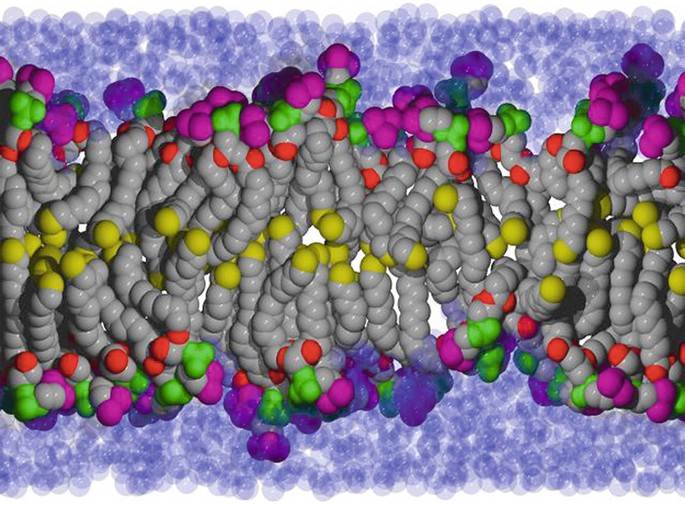Characterization of Lipid Membranes
Phospholipid represents the basic component of biofilm. They are the main components of the plasma membrane, which is one of the most basic barriers of cells and delimits the space domain of cells from the outside world. Phospholipids have abundant nuclear numbers, which makes them particularly suitable for solid-state NMR spectral analysis.
 Figure 1. Nanostructure of a lipid bilayer in the fluid, liquid-crystalline (Lα) phase (Molugu et al., 2018)
Figure 1. Nanostructure of a lipid bilayer in the fluid, liquid-crystalline (Lα) phase (Molugu et al., 2018)
As an expert in the field of nuclear magnetic resonance, Creative Biostructure provides customers with solid-state NMR spectrum analysis services of membrane lipids based on solid-state deuterium NMR spectrum. Using solid-state 2H NMR relaxation, the effects of acyl length, polyunsaturation, lipid polar head group, auxiliary surfactant, water and sterol incorporation on the viscoelastic properties of the bilayer can be obtained.
Our Technology
Solid-state nuclear magnetic resonance (ssNMR) has been widely used in material chemistry, structural biology and genomics.
Solid-state deuterium (2H) NMR spectroscopy provides a unique tool for lipid membrane investigation. Through the principal value of the static or moving average coupling tensor, the knowledge of the average structure can be obtained from the solid-state 2H NMR linetype.
For randomly oriented multicellular lipids or aligned membranes, this technique provides the residual quadrupole coupling (RQC) of a single C-2H -labeled segment. The RQC value is used to calculate the segment order parameter S(t)CD, which is related to the average film characteristics.
The corresponding dynamic information can be obtained from the tensor wave, which depends on the mean square amplitude and velocity of motion.
The fluctuation of coupling Hamiltonian caused by various membrane dynamics leads to relaxation. The solid-state 2H NMR relaxation method is helpful to study the hierarchical dynamics of liquid crystal films on a wide length and time scale. The complex lipid dynamics can be understood by model-free interpretation of the spin-lattice relaxation rate as a function of the segmented order parameters.
The outstanding aspect of 2H NMR is that it enables membrane lipids and membrane proteins to be studied by replacing 1H with 2H. The structural data are highly complementary to X-ray and neutron diffraction studies and can obtain almost unique information about the functional dynamics of membrane components.
Achievable Membrane Lipid Characterization at Creative Biostructure
Analysis of equilibrium and kinetic characteristics of membrane lipids by solid-state deuterium nuclear magnetic resonance spectroscopy
We introduce site-specific 2H markers to obtain atomic resolution information. In the liquid crystal film, we will measure the nuclear spin relaxation rate, such as the relaxation of Zeeman order (R1Z) or quadrupole order (R1Q), which depends on the molecular mobility. By combining 2H NMR ordered parameter measurement and relaxation study, we can detect the structural fluctuations of fluid membrane lipids.
Direct observation of coupling tensors related to molecular structure and dynamics by deuterium nuclear magnetic resonance spectroscopy
Through magnetic interaction (dipole coupling, chemical shift) and electrical interaction (quadrupole coupling), we can analyze and obtain information about the structure and dynamics of biomolecular systems. In general, the principal values and principal axis systems (PAS) of various coupling tensors produce structural knowledge, and their fluctuations cause spectral transitions and are related to the dynamics of the systems of interest.
Other analysis services
- Dynamic characteristics of lipid membrane revealed by deuterium spin-lattice relaxation time.
- Use the order parameters provided by deuterium NMR as the spectral observation values related to the average film characteristics.
- Detailed comparison of the structure and kinetic characteristics of the films using deuterium nuclear magnetic resonance relaxation.
Creative Biostructure is committed to providing high-quality NMR analysis services to advance the life sciences fields. If you have any questions or needs, please contact us and our customer service staff will help you the first time.
Ordering Process
Reference
- Molugu T R, Xu X, Leftin A, et al. Solid-state deuterium NMR spectroscopy of membranes. Modern Magnetic Resonance. 2017: 1-23.

